| Team Owners Are Interested In Power And Money, Not Sport |

Article by Simon Barnes for Times Online
 hat a loaded English football team! hat a loaded English football team!
- Up front - Wayne Rooney, £33 million, and Michael Owen, £40 million
- On the wings - David Beckham, £125 million, and Ryan Giggs, £32 million
- Centre backs - Rio Ferdinand and Sol Campbell, £33 million each
- Managed by - Fabio Capello, £34 million
The Sunday Times does a separate rich list for sport. That's because we have a special fascination for the marriage between money and sport.
And so we read of the fortunes of top performers, of managers (at £30 million, Roy Keane beats Sir Alex Ferguson by £6 million), and investors (Roman Abramovich £7.4 billion, Mohamed Al Fayed £650 million). Money, money, money.
Read the sports section of the newspaper any day of the week - more and more money stories. We have to bring in our colleagues from the business section to explain them. Clubs go into administration, others are bought by people who don't actually have the money to buy them, but that's okay because enough people believe they might well have the money one day.
It's all beyond me. We need business expertise to follow every sport in the calendar. Cricket is reeling from the fall of Lalit Modi, suspended as commissioner of the Indian Premier League for alleged financial irregularities. You really need an MBA to write for the sports pages these days.
How come there is so much money in sport? There never used to be. Sport was not invented to make money. It was invented to amuse its participants. But it was found to amuse spectators, who were willing to pay for being amused. Sport began to pay participants who would otherwise miss payment for a work shift (if they wished to be thought gentlemen, they were paid surreptitiously). The definition of an amateur is an athlete who won't take a cheque.
Then came television and the realisation that lots and lots of people are willing to watch sport if it's fun and/or there is someone to cheer for. As the process began its exponential growth, so sport changed and changed again to make itself more entertaining.
Football invented the penalty shoot-out and the Champions League; cricket invented one-dayers, then Twenty20 and the IPL; tennis invented the tie-break, rugby union constantly tinkers with its laws to try to produce entertainment; rugby league turned itself into a summer sport; Formula One has changed its format yet again in an attempt to produce more excitement.
This has some odd side-effects. Most actual cricketers agree that the only serious examination of a player is his Test-match record, but Test cricket is dying. Everybody knows that to find excellence, you don't play all the time, you need to extend your career and give your best at every appearance. All sports take the opposite strategy: play the stars as much as possible while they can still stand. The aim is not excellence, it is money.
The point is that money is no longer incidental in sport. It is not a by-product of excellence, a bonus for achievement, something that we who watch are willing to applaud. Sport is no longer run by sports people for the sake of sport, it is run by businessmen for the sake of money. Sport makes its money-brokers powerful people. Power follows the flight of a ball.
These people are interested in power and money, not sport. Even those who watch are increasingly looking for a quick fix of entertainment, rather than peak performance and sustained narrative. Sport has changed dramatically in its physical form, it is now shifting its moral centre. Sport is in the middle of a long process of selling out to its lesser gift.
|
| Playing for Glory, Playing for Survival - Tale Of A Hockey Player |
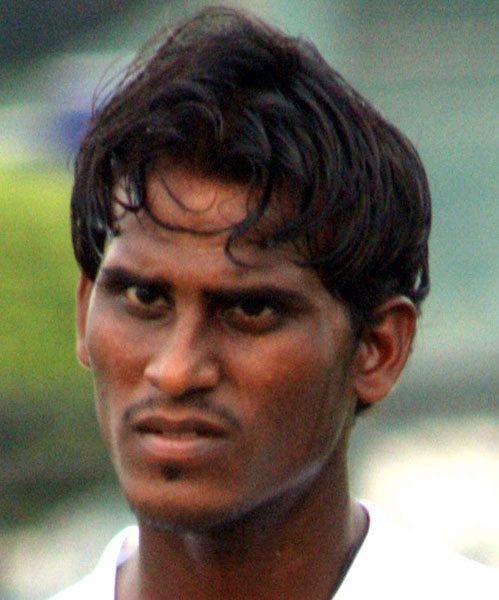
Photograph and Article courtesy Stick2Hockey.com
 mit Kumar Prabhakar's story could have been the script of a Bollywood movie. But this is no reel life melodrama. It is the very real story of innumerable Indian non-cricket sportsmen and sportswomen. mit Kumar Prabhakar's story could have been the script of a Bollywood movie. But this is no reel life melodrama. It is the very real story of innumerable Indian non-cricket sportsmen and sportswomen.
In a family headed by his mother, Kusum, 18-year-old Amit is the eldest of four siblings. When he was two, his father began working at the mess at the Guru Govind Singh Sports College, on the outskirts of Lucknow. Since then, the family has been living in a small hut on the college campus.
Amit's first hockey stick was a gift from one of the college coaches. His father dreamt that Amit would play for India, but today he isn't around to celebrate. He died of kidney failure in 2009 because the family couldn't afford a transplant.
Kusum is the sole breadwinner, earning Rs. 1,500 a month, doing odd jobs at the hostel mess. As a mother, she was worried about her son travelling to Malaysia. "How will he be able to travel in an aircraft? He has not even been in an air-conditioned train," she said.
Amit learnt his initial hockey at the Varanasi Hockey Academy, followed by a stint at the Lucknow Sports Hostel as well. He hails from Faizabad in Uttar Pradesh.
After proving his mettle for Air India, Amit went on to represent the country at the South Asian Federation Games (February 2010, Silver) and the Sultan Azlan Shah Cup (May 2010, Gold).
After his selection for the Azlan Shah tournament, Amit said, "It's going to be the biggest chance of my life. All eyes, especially my family's, are on me, and I have to live up to their expectations."
For Amit and his family, the joy and honour of representing the country are countered by some practical considerations. The first question on his mother's mind has to do with survival. "Will Amit be earning more money? Will he be able to feed the family and get his sister married? I know he plays well, even though I haven't seen him. I hope he does his best, because our financial future depends on his success."
Amit's brother Ajay is proud of his elder brother's achievement, saying that Amit deserved the India call on the basis of his showing at the South Asian Games. But Ajay also echoed his mother's words, that Amit's sports career is the only way out of his family's poverty. Amit, like many other talented Indian non-cricket sportsmen, has to shoulder the hopes of a family that has very little else.
|
| My Unforgettable Visit To Kodagu - By Sports Minister M. S. Gill |
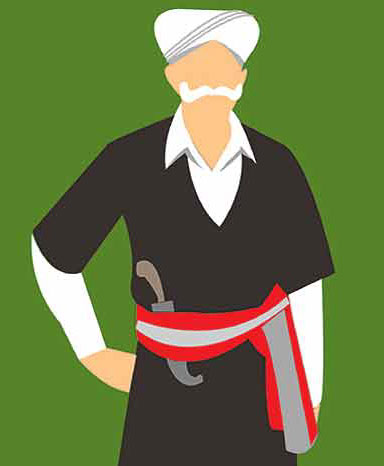
Article by Union Sports Minister M. S. Gill, courtesy Outlook
 am aware that there are three major cradles of hockey in India. The first is Punjab, and the second is the tribal belt of Orissa-Jharkhand. The third, clearly, is Kodagu in Karnataka. am aware that there are three major cradles of hockey in India. The first is Punjab, and the second is the tribal belt of Orissa-Jharkhand. The third, clearly, is Kodagu in Karnataka.
This April, I had a chance to visit the Kodagu hills. Fifty minutes by chopper from Bangalore, these forested hills, 2,500-4,500 feet high and with valleys full of paddy fields, are a southern delight. They are home to some 1.5 lakh Kodagus or Coorgis, who seem an isolated racial group in the Deccan. Most of them are tall and fair, with sharp, Arabic hook-noses. Like the Scots, the Kodagus are divided into clans—there are some 800 of them. They are a proud people with a warrior history, and are fond of arms and sports.
I went to Kodagu to inaugurate an amazing sports event - the XIVth edition of the Kodagus' family hockey festival. If proof were needed of their love of hockey, one only needs look at the 40 international players this people have produced, among them M. P. Ganesh, B. P. Govinda, M. M. Somaiyya, C. S. Poonacha, and the more recent Arjun Halappa.
In 1997, Pandanda Kuttappa decided to organise a hockey tournament for the clans. 60 teams came in the first year; for the edition I went to inaugurate, there were 214. The women play too, in a combined team, and married women play for the clans they have married into.
Each year, families of one clan pool their resources to organise and host the tournament, which is played out over a month, with elimination matches held daily. There are food stalls and other pavilions; the men come dressed in traditional robes, the women in sarees worn in the special Coorgi style; the air is vibrant and festive.
This time, the tournament was held at an elegant bamboo stadium in Ponnampet that could accommodate 25,000 spectators. It was erected by the Maneyapanda clan. Almost everyone from the hills turned up for the inauguration, all in ceremonial dress. Entry was free. I have never seen such a sight—such a fun gathering of a happy, disciplined people. The North has much to learn from them.
The inaugural match was between an India XI team led by Dhanraj Pillai and a local Kodagu XI brimming with young talent. The Coorgis won the spirited match 2-1.
The tournament itself is an amazing voluntary effort to promote hockey and produce stars. I admire the Kodagu people: they are soldiers and sportspersons. Is there a better combination one could ask for?
Last year, a hockey astroturf was inaugurated in Madikeri (also known as Mercara), the headquarters of Kodagu district. The people have asked for one more, and we will find ways to provide it so that the new style of hockey can be learnt and promoted for the needs of the Indian team.
During the visit, I stayed at a coffee estate. Coffee is said to have arrived in these hills via the trading dhows of the Gulf. The story goes that a holy man returning from Mecca smuggled back six forbidden seeds. The likelier explanation is that the plantations were created by the British. Far from Delhi, it was a relief to stay in a rambling house surrounded by coffee gardens and shaded by giant trees of every variety. An ancient bougainvillea that had become a tree dripped purple. A huge cotton tree was opening its buds and sending puffballs floating down. Coconut palms and bauhinias were aplenty.
One morning, I was told an elephant had been to the nearby pond to drink. He had come all the way and slid down the steep mud slopes. I went and saw the footmarks.
There are plenty of outdoor possibilities in this scenic region. I played golf one morning with local planters over rolling hills. It was great fun. I was happy to learn that many coffee estates provide home stays, ideal for tourist families, with relaxation for the elders and plenty of outdoors for the young.
Looking at the landscape, I suddenly realised why the British under Wellesley fought so hard to overcome Tipu Sultan. The land was simply too rich to be left with him.
One last word: long ago, a quirky Brit in a soporific mood, perhaps after pink gins in Mercara, had directed that the Coorgis were free to carry guns without licences for, as a martial race, guns were part of their culture. I am surprised that 60 years after the British left, no Indian babu has thought of cancelling this privilege. As a Sikh, allowed a mere kirpan, I felt jealous!
|
| India Repeat As Winners At The 19th Azlan Shah Tournament |
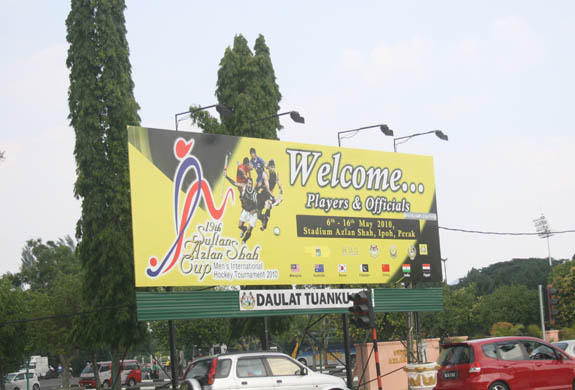
Photograph courtesy Stick2Hockey.com
 he 19th Sultan Azlan Shah Cup was held in Ipoh, Malaysia from May 8 to May 16. Seven countries took part in the tournament: he 19th Sultan Azlan Shah Cup was held in Ipoh, Malaysia from May 8 to May 16. Seven countries took part in the tournament:
- Malaysia (host)
- India (defending Azlan Shah Cup champion)
- Australia (World Champions)
- South Korea (defending Asian Games and Asia Cup champions)
- China (Asian Games silver medallist)
- Pakistan (Asia Cup silver medallist)
- Egypt (Africa Nos. 2)
India's match results in the tournament were as follows:
| Stage |
Date |
Score |
Goal Scorers (IND) |
| League |
May 6 |
India 1 - China 1 |
Ravipal Singh (70 min) |
| |
May 7 |
India 4 - Pakistan 2 |
Sardar Singh (25 min)
Mandeep Antil (47 min)
Gurbaj Singh (53 min)
Tushar Khandker (56 min) |
| |
May 9 |
India 3 - South Korea 2 |
Arjun Halappa (10 min)
Tushar Khandkar (45 min)
Shivendra Singh (60 min) |
| |
May 10 |
India 4 - Australia 3 |
Tushar Khandkar (19, 32 min)
Rajpal Singh (21 min)
Shivendra Singh (61 min) |
| |
May 12 |
Malaysia 5 - India 2 |
Danish Mujtaba (44 min)
Ravi Pal Singh (67 min) |
| |
May 15 |
India 7 - Egypt 1 |
Dhananjay Mahadik (34, 40, 42 min), HT
Rajpal Singh (44 min)
Rupinder Pal Singh (48 min)
Tushar Khandkar (49 min)
Sarvanjeet Singh (70 min) |
| Final |
May 16 |
Rained out after 6 minutes |
India, South Korea joint winners |
This is India's 5th title victory at the Azlan Shah tournament, having won in 1985, 1991, 1995, 2009 and now joint winners in 2010. Since the inception of the tournament, this is the first time that 2 teams were declared joint champions.
The final positions of the 2010 Azlan Shah tournament were: 1. India, South Korea; 3. Australia; 4. Malaysia; 5. Pakistan; 6. China; 7. Egypt
The following tournament awards were given:
- Top Goal Scorer of the Tournament: Nam Hyun Woo (South Korea) - 9 goals
- Goalkeeper of the Tournament: S. Kumar (Malaysia)
- Player of the Tournament: Sardar Singh (India)
- Fairplay Trophy: Egypt
The Indian team for the 2010 Azlan Shah tournament was as follows:
Goalkeepers: Parattu Ravindran Sreejesh, Bharat Chetri
Full-backs: Dhananjay Mahadik, Bharat Chikara, Amit Prabhakar, Rupinder Pal Singh, Sardar Singh
Half-backs: Prabodh Tirkey, Ravipal Singh, Gurbaj Singh, Arjun Halappa, Vikas Vishnu Pillai, Danish Mujtaba
Forwards: Rajpal Singh (captain), Shivendra Singh, Mandeep Antil, Tushar Khandkar, Sarvanjeet Singh
Officials: Jose Brasa (chief coach), Harendra Singh (manager)
|
| Indian Women Win 5-Test Series 2-1 Against New Zealand |
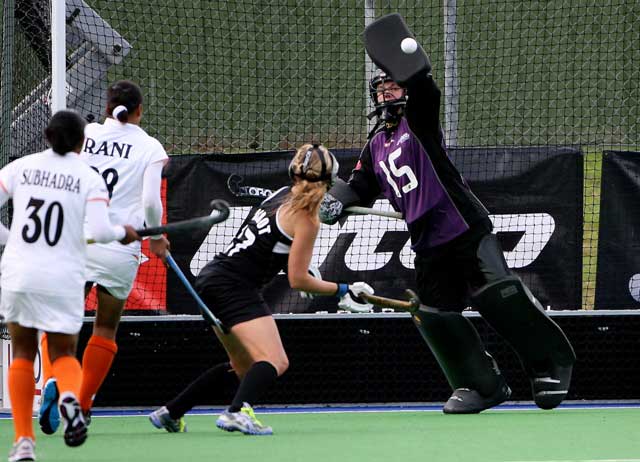
New Zealand goalkeeper making a save; Photograph courtesy New Zealand Hockey Federation
 he Indian women's hockey team played a 5-test series with New Zealand from May 15-23, as part of their preparation for the World Cup, Commonwealth and Asian Games later this year. he Indian women's hockey team played a 5-test series with New Zealand from May 15-23, as part of their preparation for the World Cup, Commonwealth and Asian Games later this year.
The first two tests were played at Endeavour Trust Twin Turfs in Palmerston North, the third at Kett Capital Hockey Stadium in Napier, and the last two matches at the National Hockey Stadium in Wellington. The final match of the series was televised live on SKY Sport 1 in New Zealand.
India won the 5-test series 2-1, with the following match results:
| Venue |
Date |
Matchup |
Goal Scorers (India) |
| Palmerston North |
May 15 |
India 3 - New Zealand 2 |
Rani Rampal (18, 20, 46 min), HT |
| |
May 16 |
India 2 - New Zealand 2 |
Rani Rampal (34 min), FG
Subhadra Pradhan (69 min), PC |
| Napier |
May 19 |
India 2 - New Zealand 2 |
Saba Anjum (4 min)
Chanchan Devi Thockchom (8 min), PC |
| Wellington |
May 22 |
India 3 - New Zealand 1 |
Surinder Kaur (43 min)
Saba Anjum (64 min)
Rani Rampal (69 min) |
| |
May 23 |
New Zealand 1 - India 0 |
|
The victorious Indian team was as follows:
Goalkeepers: Deepika Murthy, E. Rajini
Defenders: Binita Toppo, Subhadra Pradhan, Joydeep Kaur
Midfielders: Ritu Rani, Mukta Barla, Deepika Thakur, Kirandeep Kaur, Rosalin Ralte
Forwards: Surinder Kaur (captain), Jasjeet Kaur Rani, Saba Anjum, Chanchan Devi, Rani, Soundarya Yendala, Poonam Rani, Monika Badran
Coach: M. K. Kaushik
|
| Photograph of the Month |
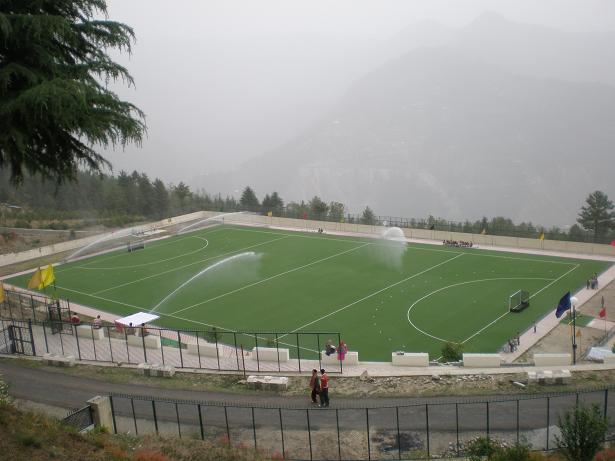
Photograph courtesy Stick2Hockey.com
 he Photograph of the Month for June 2010 is of the highest hockey artificial turf ground in India. The turf is located at at the Netaji Subhash High Altitude Training Center (HATC) at Shilaroo, about 60 kms from Shimla in Himachal Pradesh. he Photograph of the Month for June 2010 is of the highest hockey artificial turf ground in India. The turf is located at at the Netaji Subhash High Altitude Training Center (HATC) at Shilaroo, about 60 kms from Shimla in Himachal Pradesh.
At an altitude of 2420 meters (8000 feet) from sea level, this is possibly also Asia's highest artificial turf hockey ground.
Union Sports Minister Manohar Singh Gill inaugurated the Rs. 3.53 crores artificial turf and indoor multi-purpose sports training hall, hostels and medical center on May 18. Vidya Stokes, who is currently the temporary president of Hockey India, was also present on the occasion. Incidentally, Shilaroo is her home constituency, and she is now the Opposition Leader of Congress in the Himachal state assembly.
While addressing the gathering, Gill pointed out that Indian hockey suffered extensively due to lack of modern sports infrastructure like artificial turf carpeted stadiums, which have otherwise been common around the world since 1975-76.
This high altitude centre came into prominence in 2003, when Indian camp moved from Lucknow to Shilaroo, with Sampath Kumar as the physical trainer in charge. Dhanraj had his birthday celebrated here, with a half dozen television cameras beaming it live across the country.
HATC Shilaru was a dream sports project of the late Prime Minister Rajeev Gandhi, the foundation stone of which was laid in February 1987.
|
| Money Matters |

Madhya Pradesh Chief Minister Shivraj Singh Chauhan
 adhya Pradesh chief minister Shivraj Singh Chauhan has done more for Indian hockey in the first 5 months of 2010, then politicians and officials have done in 5 years. adhya Pradesh chief minister Shivraj Singh Chauhan has done more for Indian hockey in the first 5 months of 2010, then politicians and officials have done in 5 years.
January 28, 2010: Shivraj Chauhan contributed a whopping Rs. 1 crore to the women's hockey team, distributed among 50 women players and officials, with each person getting Rs. 2 lakhs, at a function held at the Sports Authority of India centre in Bhopal.
March 23, 2010: Shivraj Chauhan inaugurated the Obaidullah Khan Gold Cup Hockey Tournament at Aishbagh Stadium, revived after 8 long years by the state Directorate of Sports and Youth Welfare. With a total prize money of Rs. 10.5 lakhs, the Obaidullah Khan Gold Cup became the top prize money hockey tournament of India.
March 29, 2010: Before the final of the Obaidullah Khan Gold Cup, Shivraj Chauhan presented a cheque for Rs. 18 lakhs to the Indian men's World Cup team. In addition, local lads Shivendra Singh (Gvalior) and Sameer Dad (Bhopal) were given Rs. 1 lakh each. The chief minister also announced an upcoming All-India Women's Hockey Tournament at Bhopal.
April 30, 2010: A nine-day All India Women's Hockey Tournament was successfully completed in Bhopal. This was the highest ever prize money awarded for a women's hockey tournament. The winner of the tournament got Rs. 2 lakhs, the runner-up Rs.1 lakh, and the third and fourth place teams got Rs. 75,000 and Rs. 50,000 respectively.
May 30, 2010: Shivraj Chauhan presented Rs. 50,000 to each Indian men's hockey player as well as coach Brasa for emerging joint winners at the Sultan Azlan Shah Cup. The chief minister said that he was willing to keep blank cheques ready if the Indian team continued to win in the same vein. The Indian team reciprocated by gifting an official jersey of the Indian hockey team, signed by each player, to the chief minister.
|
| Media Matters |

 he following matches of the the 2010 Sultan Azlan Shah Cup tournament were telecast - live, tape delayed or highlights - on the Astro Arena channel in Malaysia. he following matches of the the 2010 Sultan Azlan Shah Cup tournament were telecast - live, tape delayed or highlights - on the Astro Arena channel in Malaysia.
The Azlan Shah Cup hockey tournament is Asia's only hockey tournament. It has been held for the past 19 years. India are 5-times winners of this tournament.
Yet, not a single television channel in all of India telecast any of India's matches at the 19th Azlan Shah tournament.
|
| Visitor of the Month |
 he June 2010 Visitor of the Month is Rajendra Shah, who wrote the following to BharatiyaHockey.org: he June 2010 Visitor of the Month is Rajendra Shah, who wrote the following to BharatiyaHockey.org:
The 2010 Vadodara Hockey League is being organised by the Baroda District Hockey Association at the hockey ground opposite Rajmahal Gate.
The men's tournament will start from May 28, while the women's tournament will start from June 1. Eight teams of men and six of women will participate in the night tournament. Each team will have six players, and three games will be played every night.
For the first time, the Vadodara league results are being posted on the Internet at the link: http://www.schoolresults.info/hockey.html.
|
| Fun With Numbers |

Statistics by B. G. Joshi
 he June 2010 edition of Fun with Numbers is on gender equality in world hockey. How often has the same country won the same tournament in both the men's and women's categories? he June 2010 edition of Fun with Numbers is on gender equality in world hockey. How often has the same country won the same tournament in both the men's and women's categories?
This has never happened in the Olympics, but occured once in the World Cup, and 3 times in the Champions Trophy. This has happened most often at the contintental level events, as can be seen by the tables below:
FIH ELITE TOURNAMENTS
| Tournament |
Country |
Year |
Men's Captain |
Women's Captain |
| World Cup |
Netherlands |
1990 |
Marc Delissen |
C. Beninga |
| Champions Trophy |
Australia |
1993 |
Warren Birmingham |
Rachelle Hawks |
| |
Australia |
1999 |
Michael York |
Renita Garrard |
| |
Netherlands |
2000 |
Stephen Veen |
D.v.d. Boogaard |
CONTINENTAL CHAMPIONSHIPS
| Tournament |
Country |
Year |
Men's Captain |
Women's Captain |
| Asian Games |
South Korea |
1986 |
Ji Jae Kwan |
Hong Kim Sook |
| |
South Korea |
1994 |
Park Shin Heum |
Nu Young Mi |
| Asia Cup |
South Korea |
1993 |
Park Shin Heum |
Lim Kye Sook |
| |
India |
2003/04 |
Dhanraj Pillai |
Surajlata Devi |
| European Nations Cup |
Netherlands |
1987 |
Tom van’t Hek |
M. Bolhuis |
| All-African Games |
South Africa |
1999 |
Craig Jackson |
K. Roberts |
| |
South Africa |
2007 |
Bruce Jacobs |
Marsha Marescia |
| Africa Cup of Nations |
South Africa |
2005 |
Bruce Jacobs |
Marsha Marescia |
| |
South Africa |
2009 |
Austin Smith |
Marsha Marescia |
| Pan Am Games |
Argentina |
1991 |
Marcelo Garrafo |
Marisa Lopez |
| |
Argentina |
1995 |
A. Doherty |
Gabrila Sanchez |
| |
Argentina |
2003 |
Pablo Moreira |
Magdalena Aicega |
| America Cup |
Argentina |
2004 |
Pablo Moreira |
Magdalena Aicega |
| Oceania Cup |
Australia |
1999 |
Michael York |
Rachelle Hawkes |
| |
Australia |
2003 |
Paul Gaudoin |
Katrina Powell |
| |
Australia |
2005 |
Brent Livermore |
Nikki Hudson |
OTHER TOURNAMENTS
| Tournament |
Country |
Year |
Men's Captain |
Women's Captain |
| Commonwealth Games |
Australia |
1998 |
Michael York |
Rechelle Hawks |
| |
Australia |
2006 |
Brent Livermore |
Nikki Hudson |
| Afro-Asian Games |
India |
2003 |
Dileep Tirkey |
Surajlata Devi |
| Champions Challenge I |
New Zealand |
2009 |
Phillip Burrows |
Naylor Emily |
|
![]()